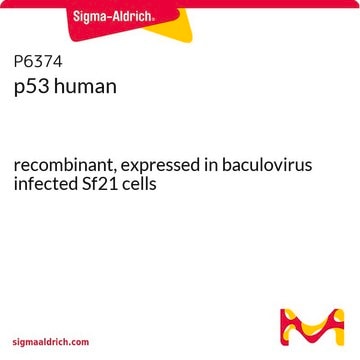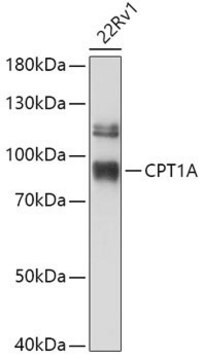ABE286
Anti-acetyl-p53 (Lys120) Antibody
from rabbit, purified by affinity chromatography
Synonym(e):
Cellular tumor antigen p53, Antigen NY-CO-13, Phosphoprotein p53, Tumor suppressor p53
About This Item
Empfohlene Produkte
Biologische Quelle
rabbit
Qualitätsniveau
Antikörperform
affinity isolated antibody
Antikörper-Produkttyp
primary antibodies
Klon
polyclonal
Aufgereinigt durch
affinity chromatography
Speziesreaktivität
human
Speziesreaktivität (Voraussage durch Homologie)
porcine (based on 100% sequence homology), canine (based on 100% sequence homology), rabbit (based on 100% sequence homology), sheep (based on 100% sequence homology)
Methode(n)
dot blot: suitable
immunoprecipitation (IP): suitable
NCBI-Hinterlegungsnummer
UniProt-Hinterlegungsnummer
Versandbedingung
wet ice
Posttranslationale Modifikation Target
acetylation (Lys120)
Angaben zum Gen
human ... TP53(7157)
Allgemeine Beschreibung
Spezifität
Immunogen
Anwendung
Epigenetik & nukleäre Funktionen
Transkriptionsfaktoren
Immunoprecipitation Analysis: 1 µg from a representative lot immunoprecipitated acetyl-p53 in p53 transfected H1299 human lung cotransfected with or without hMOF (Prof. S. McMahon, Kimmel Cancer Center of Thomas Jefferson Medical College).
Immunoprecipitation Analysis: 1.5 µg or 4.5 µg from a representative lot immunoprecipitated endogenous acetyl-p53 in HCT116 cell lysates, which were treated with a vehicle (DMSO) or camptothecin (CPT) (Prof. S. McMahon, Kimmel Cancer Center of Thomas Jefferson Medical College).
Immunoprecipitation Analysis: 1 µg from a representative lot immunoprecipitated acetyl-p53 in H1299 cell lysates, which were transfected with either wild type p53, the 9 K/R mutant (all lysine residues except Lys120 mutated to arginine), the 10 K/R mutant (all lysine residues mutate including Lys 120), or empty vector, with or without hMOF (Prof. S. McMahon, Kimmel Cancer Center of Thomas Jefferson Medical College).
Qualität
Dot Blot Analysis: 1 µg/mL of this antibody detected acetyl-p53 in acetylated p53 peptides
Zielbeschreibung
Physikalische Form
Lagerung und Haltbarkeit
Hinweis zur Analyse
Non-acetylated and acetylated p53 peptides
Sonstige Hinweise
Haftungsausschluss
Sie haben nicht das passende Produkt gefunden?
Probieren Sie unser Produkt-Auswahlhilfe. aus.
Lagerklassenschlüssel
12 - Non Combustible Liquids
WGK
WGK 1
Flammpunkt (°F)
Not applicable
Flammpunkt (°C)
Not applicable
Analysenzertifikate (COA)
Suchen Sie nach Analysenzertifikate (COA), indem Sie die Lot-/Chargennummer des Produkts eingeben. Lot- und Chargennummern sind auf dem Produktetikett hinter den Wörtern ‘Lot’ oder ‘Batch’ (Lot oder Charge) zu finden.
Besitzen Sie dieses Produkt bereits?
In der Dokumentenbibliothek finden Sie die Dokumentation zu den Produkten, die Sie kürzlich erworben haben.
Unser Team von Wissenschaftlern verfügt über Erfahrung in allen Forschungsbereichen einschließlich Life Science, Materialwissenschaften, chemischer Synthese, Chromatographie, Analytik und vielen mehr..
Setzen Sie sich mit dem technischen Dienst in Verbindung.








